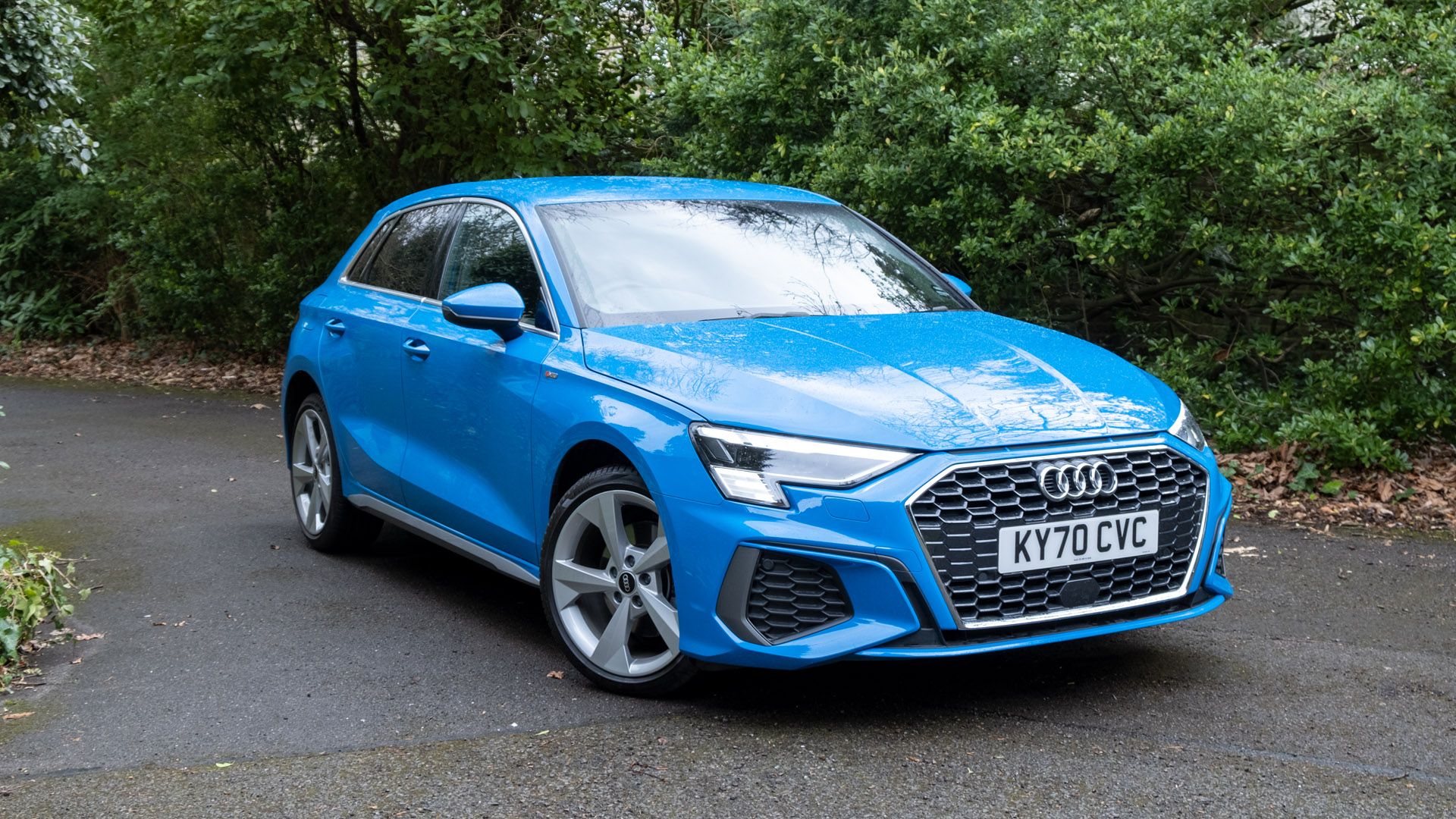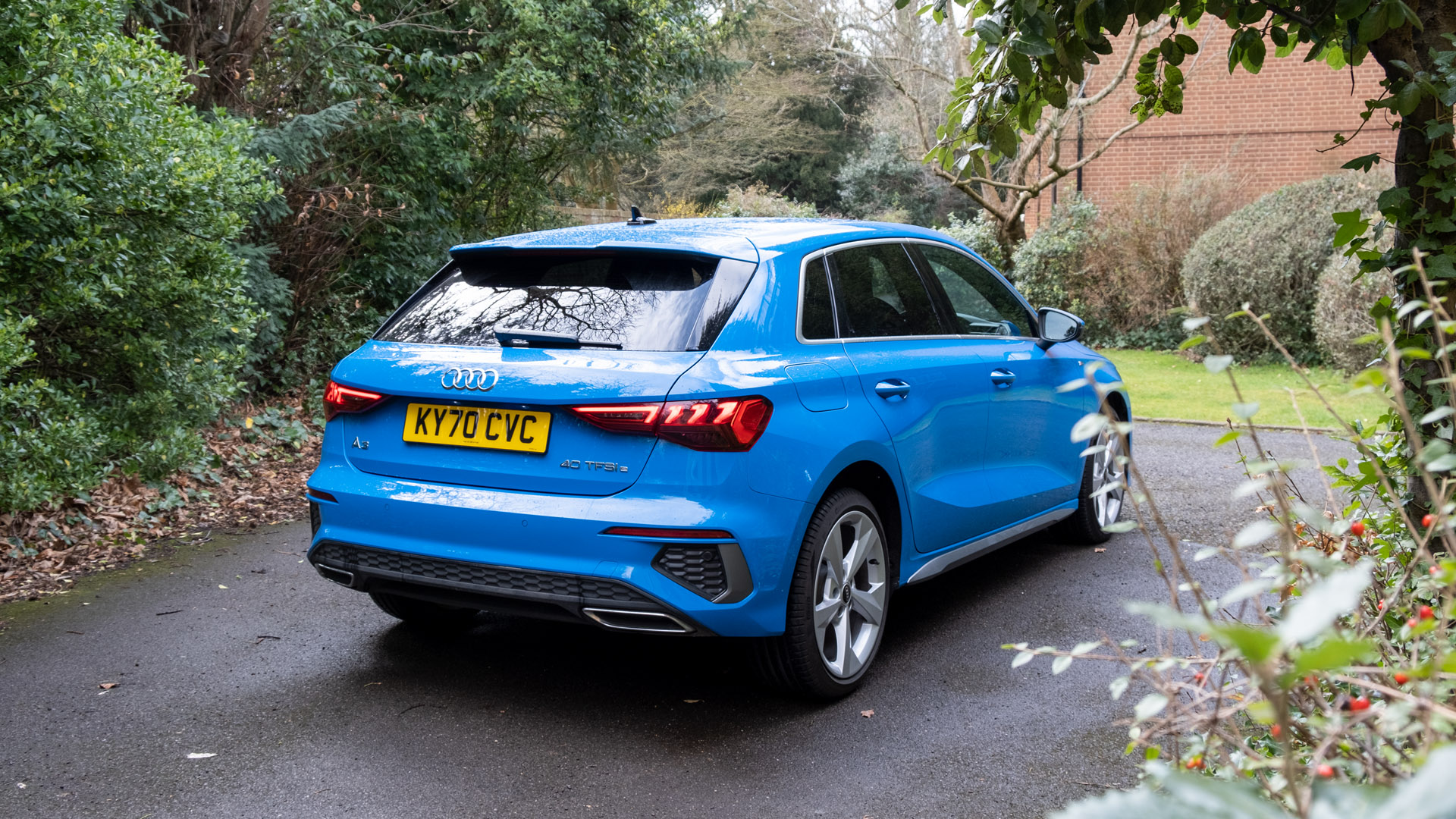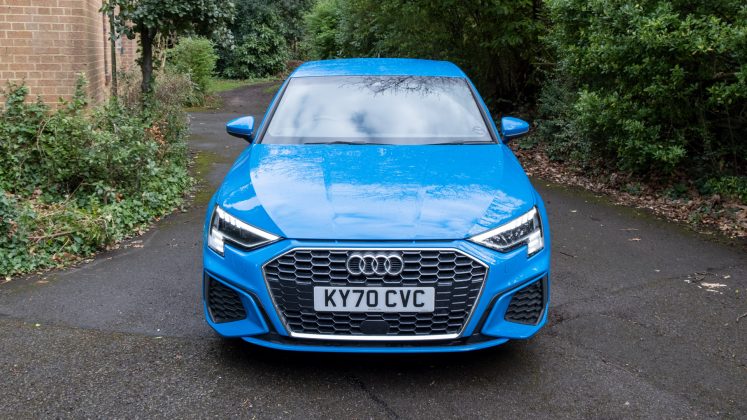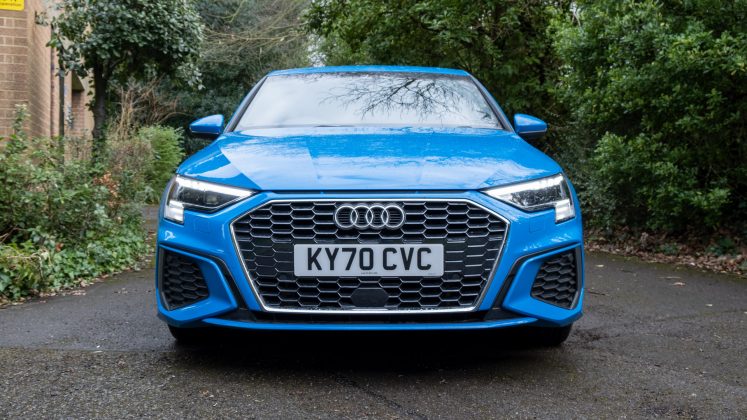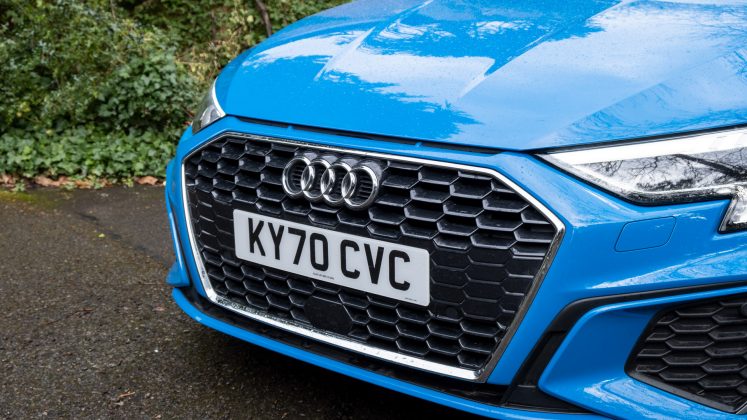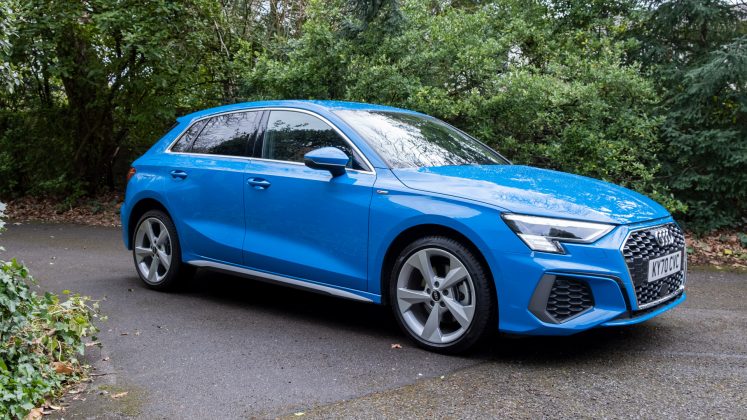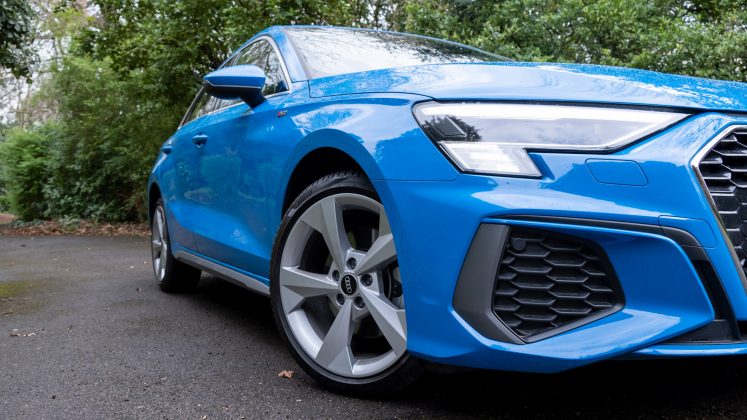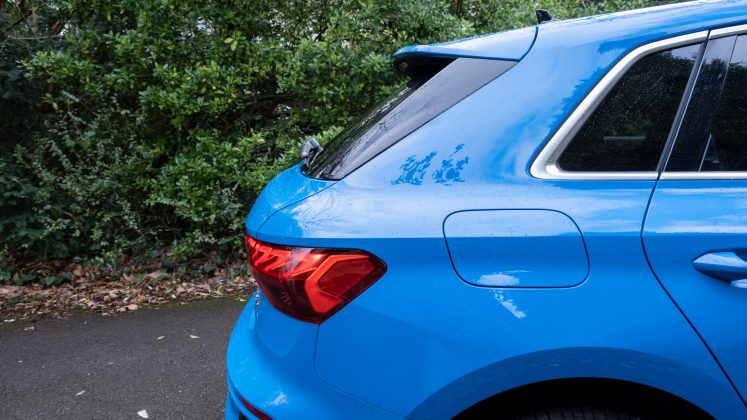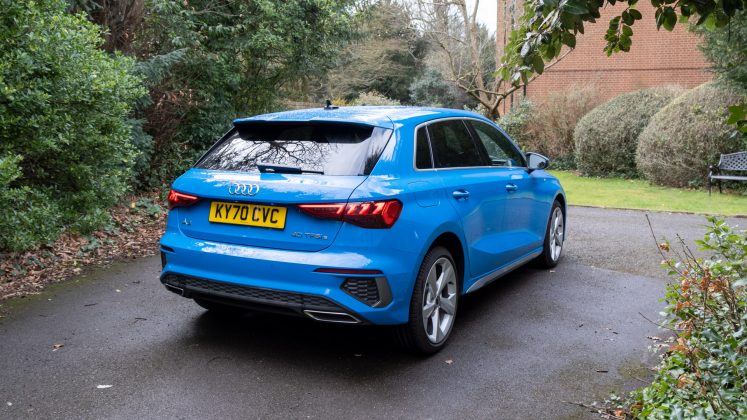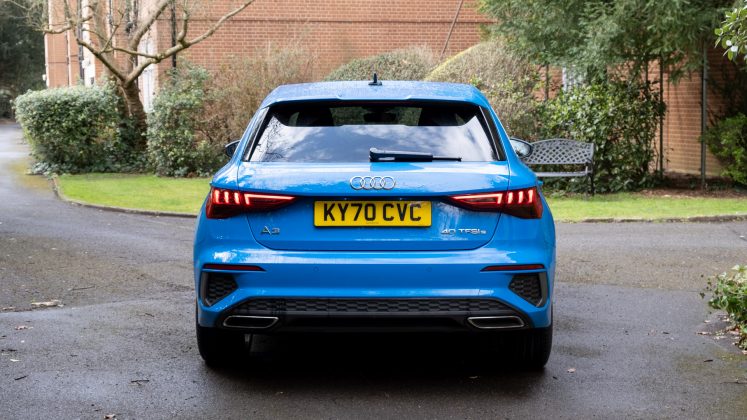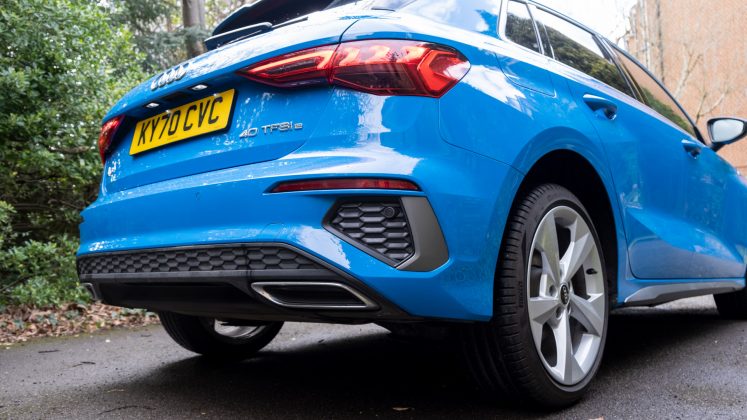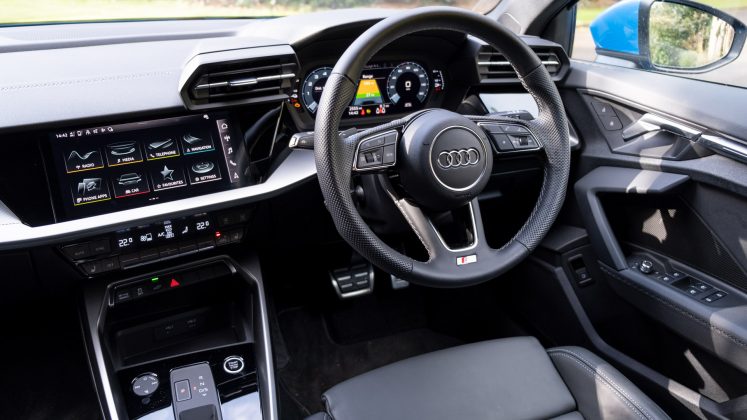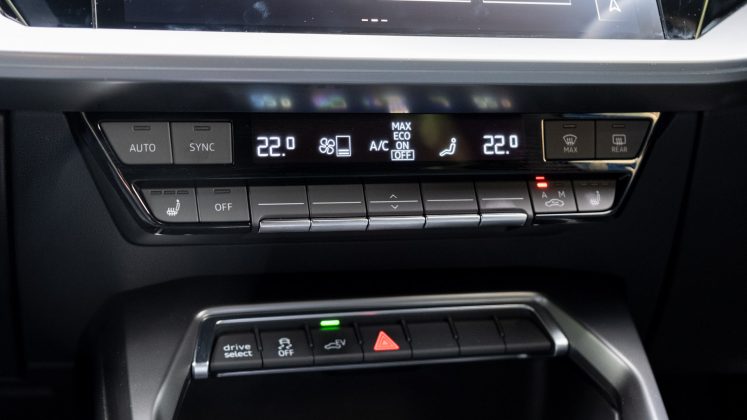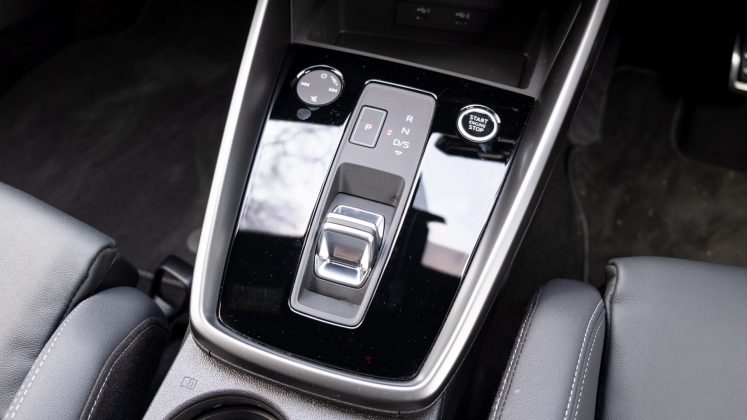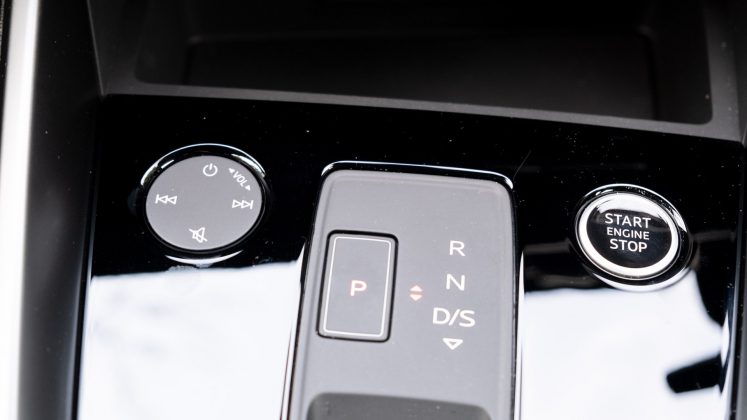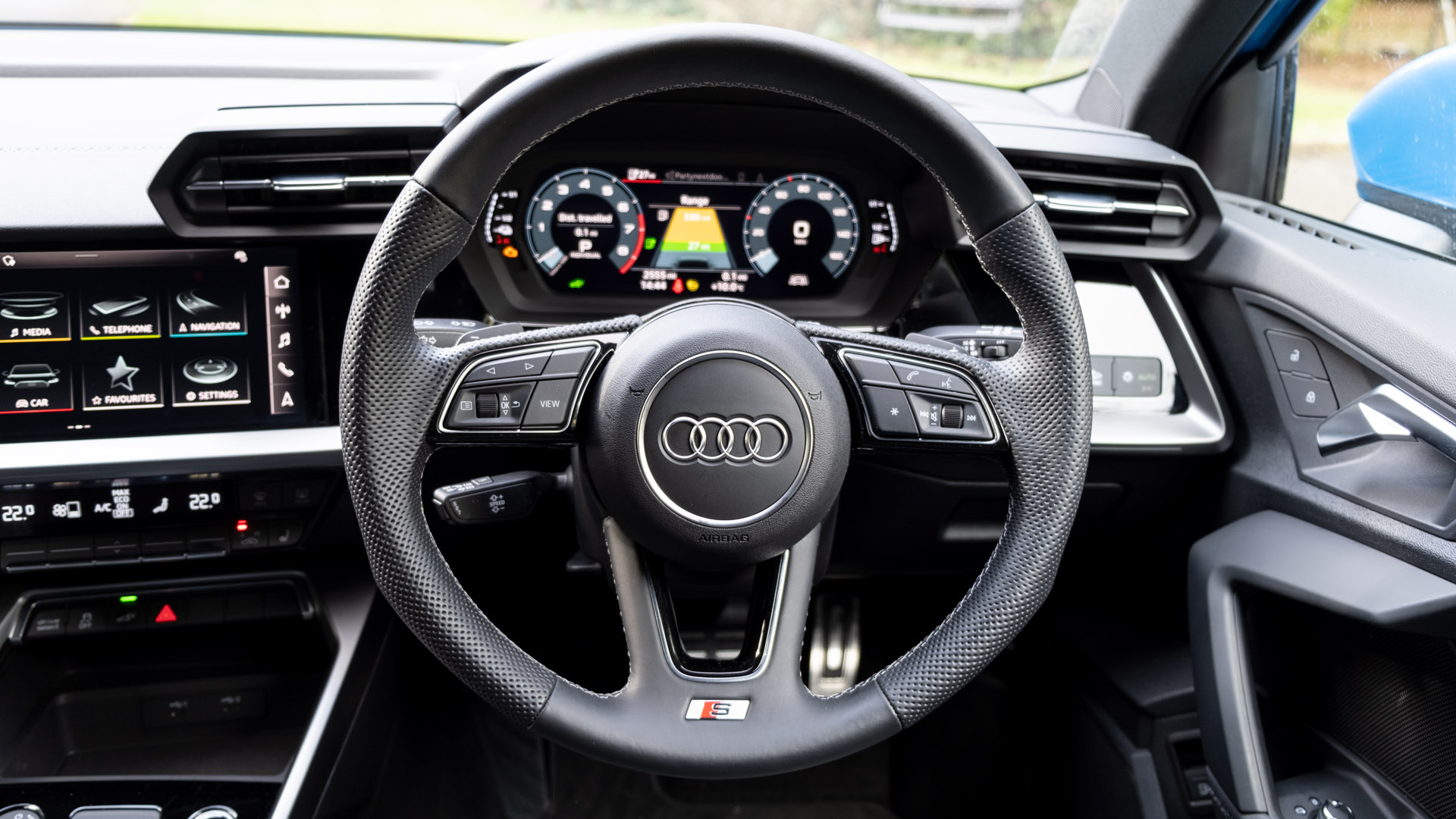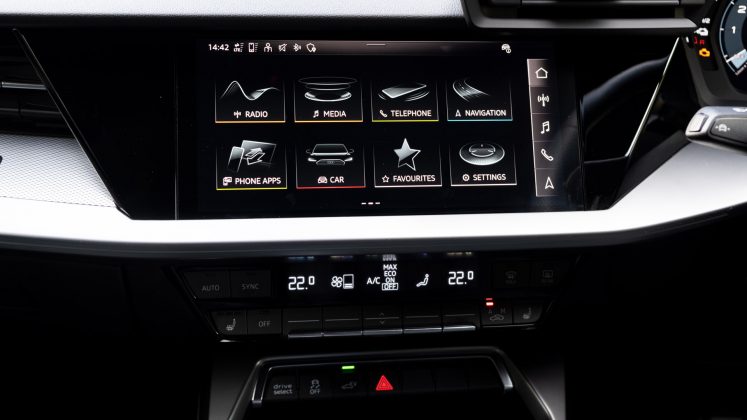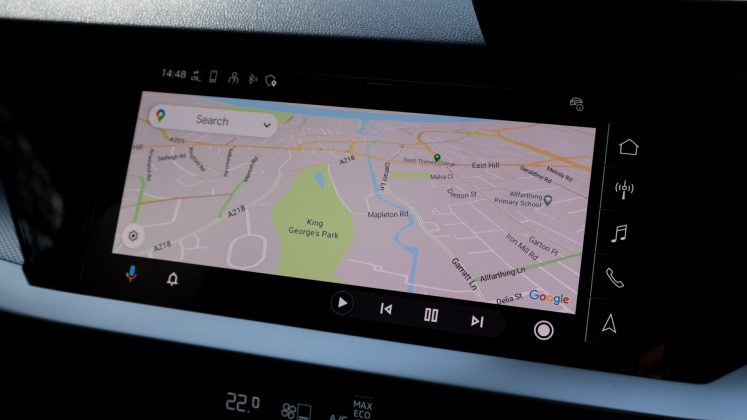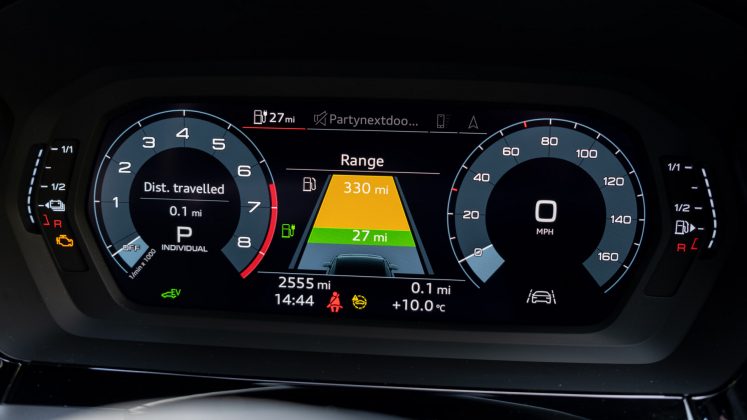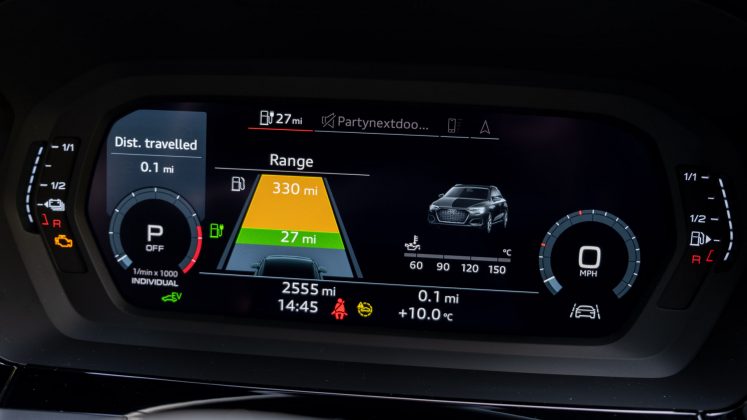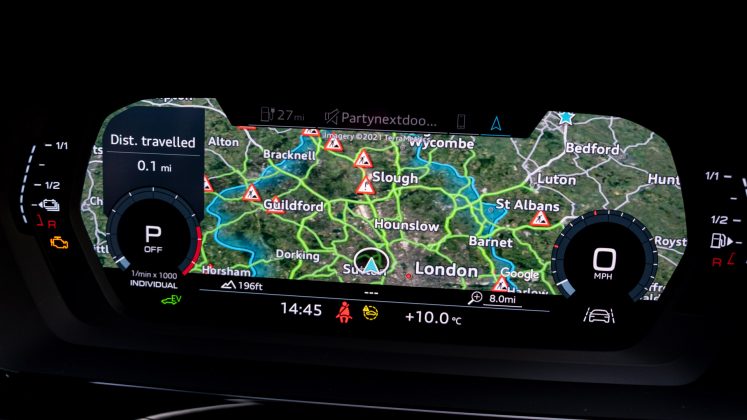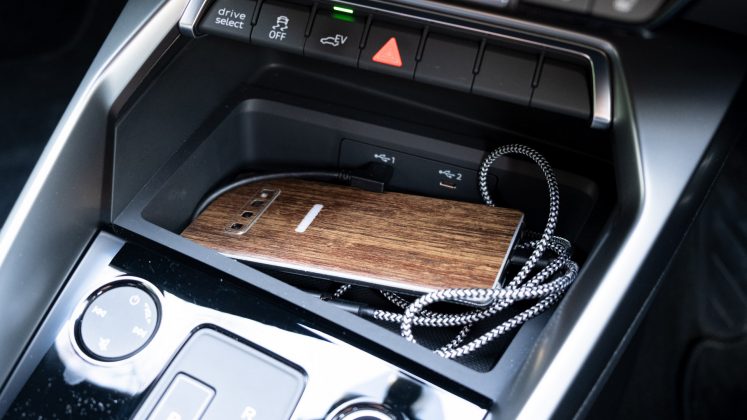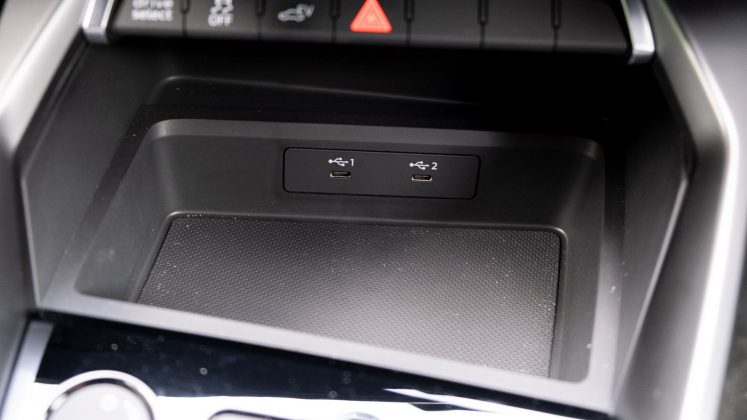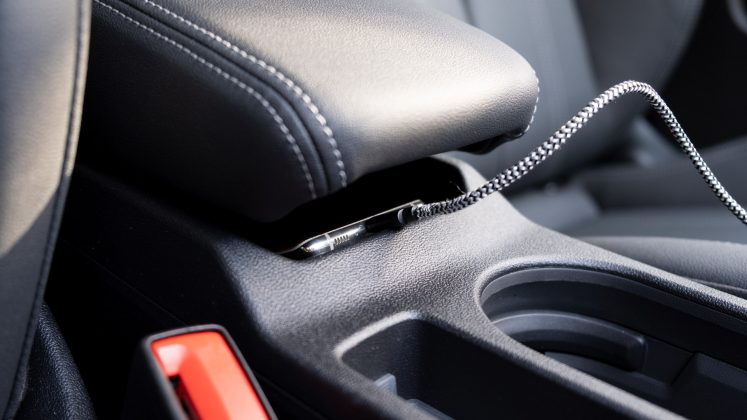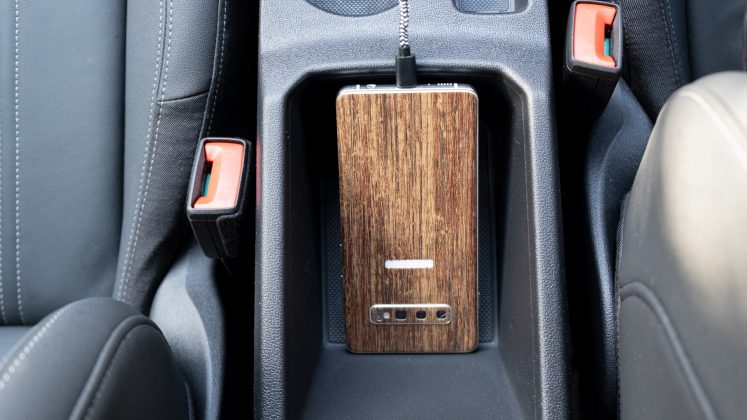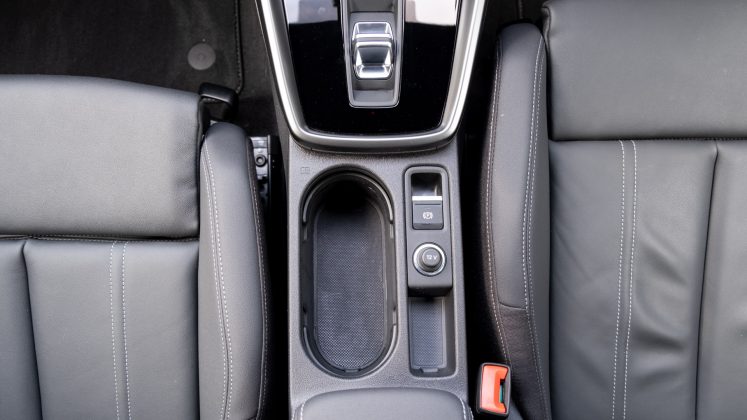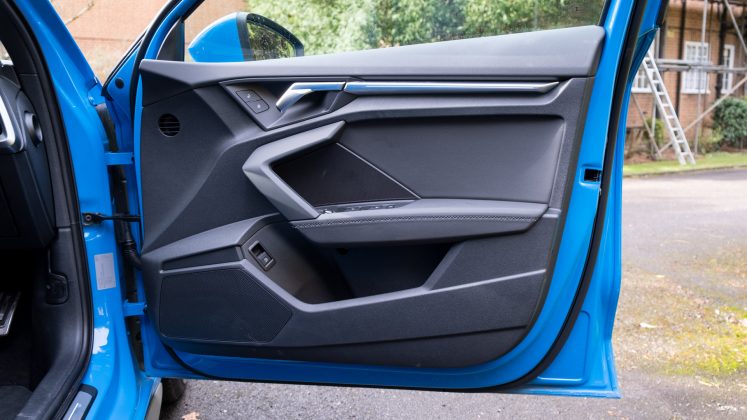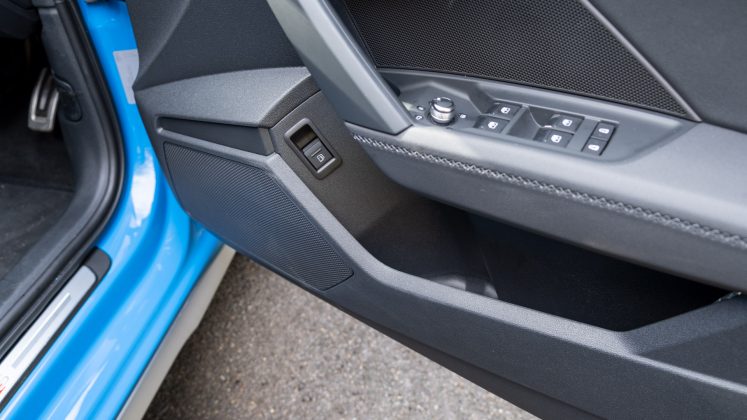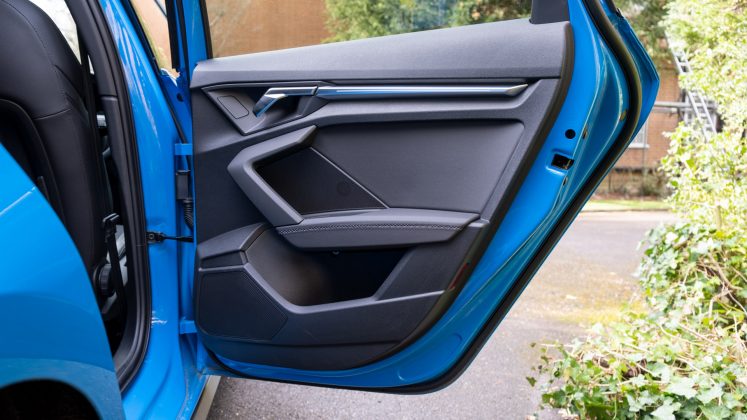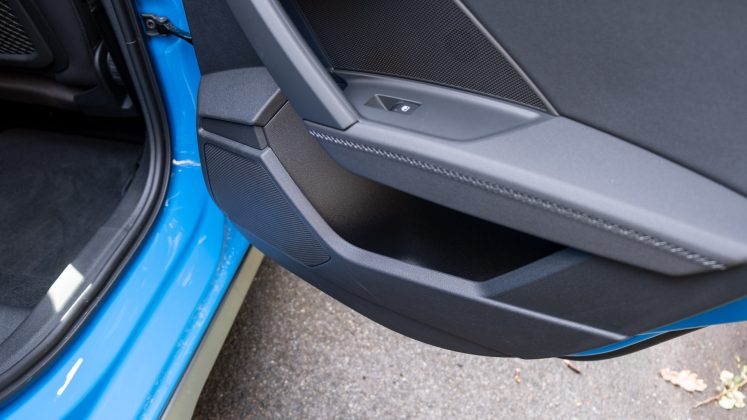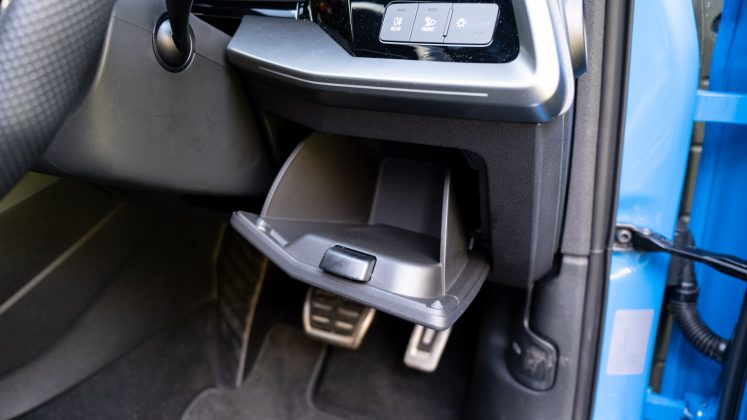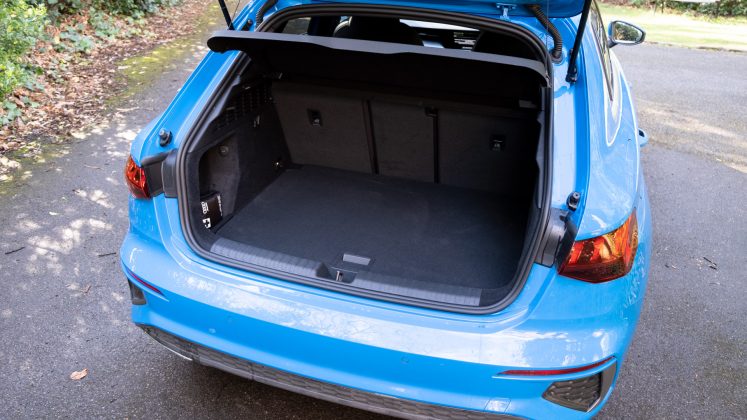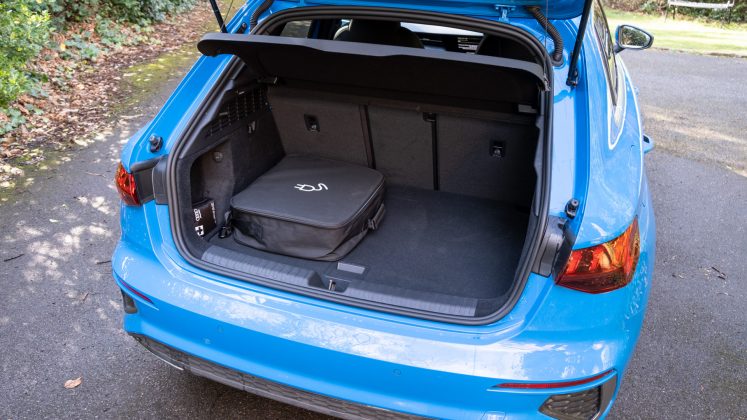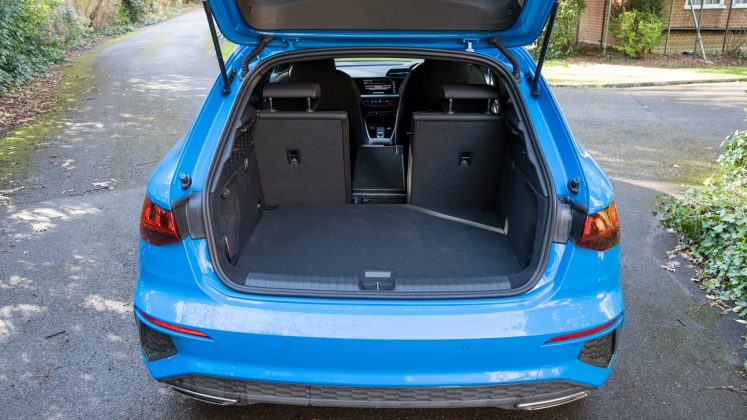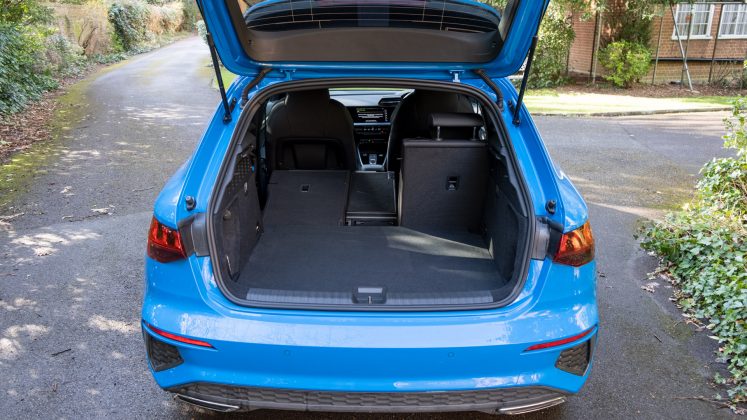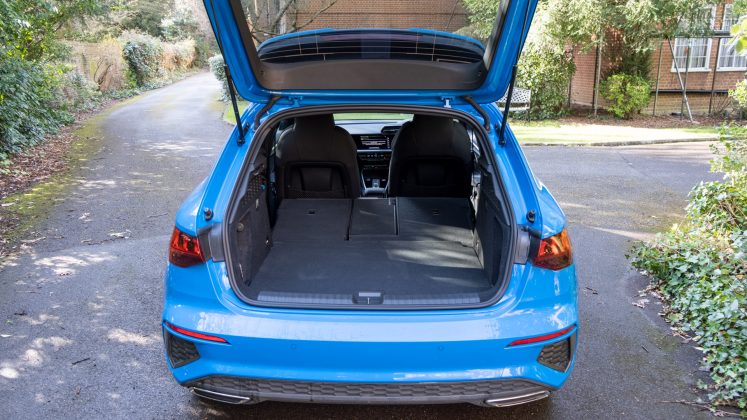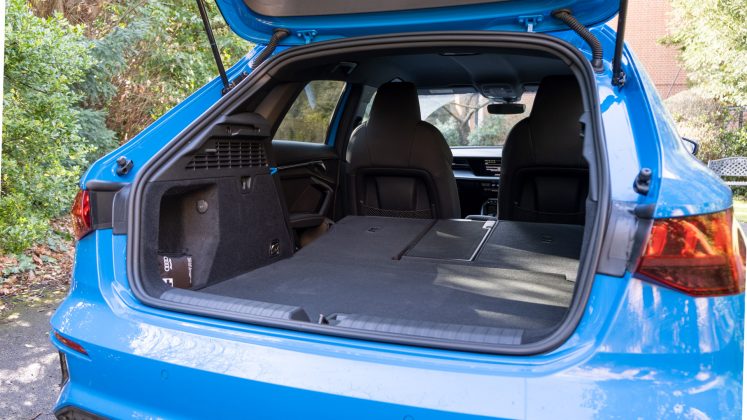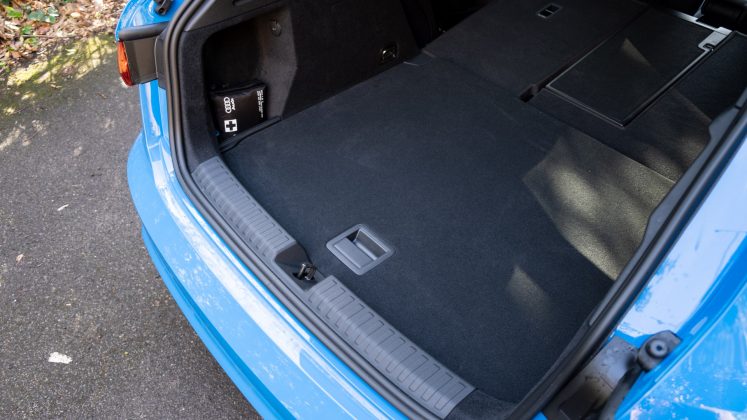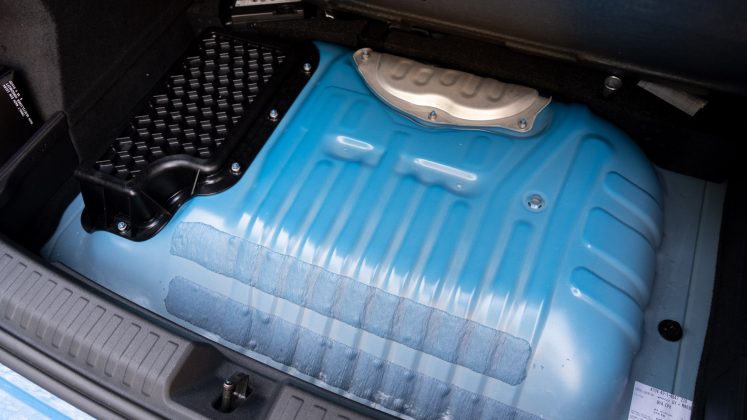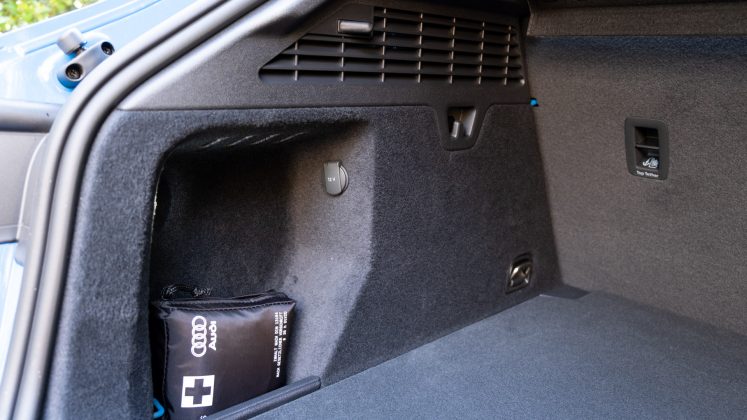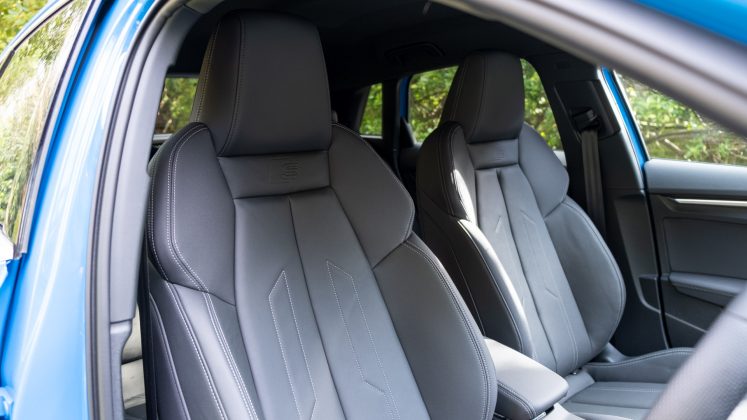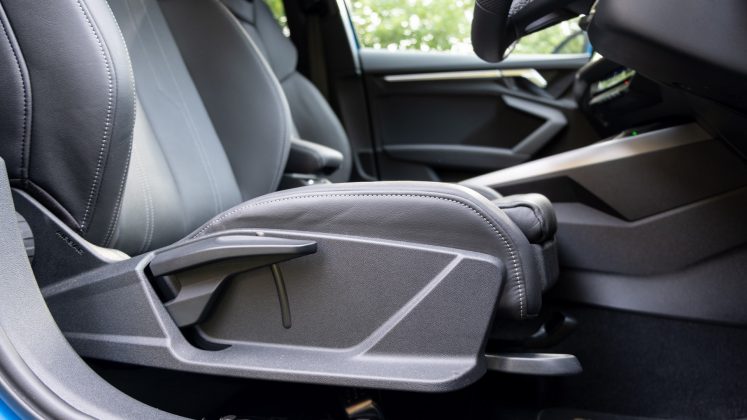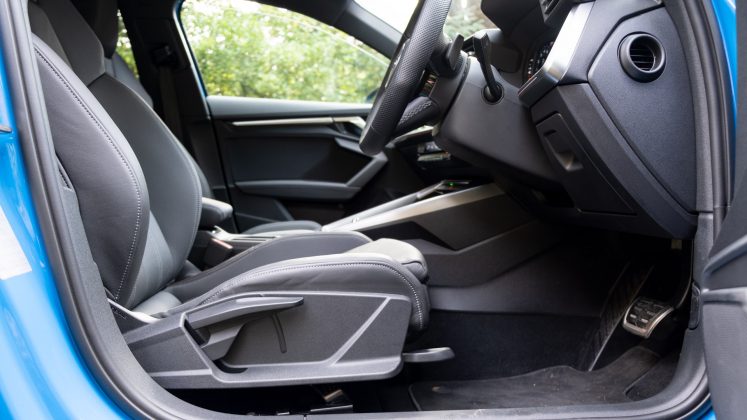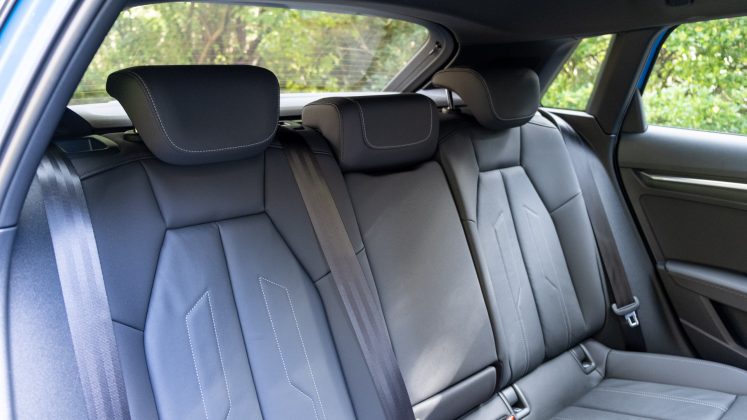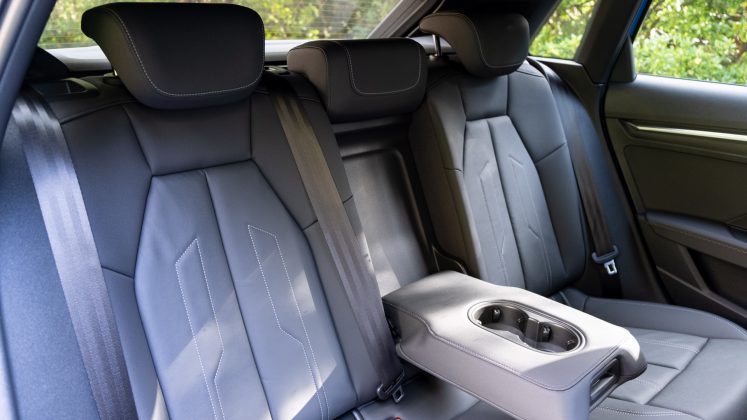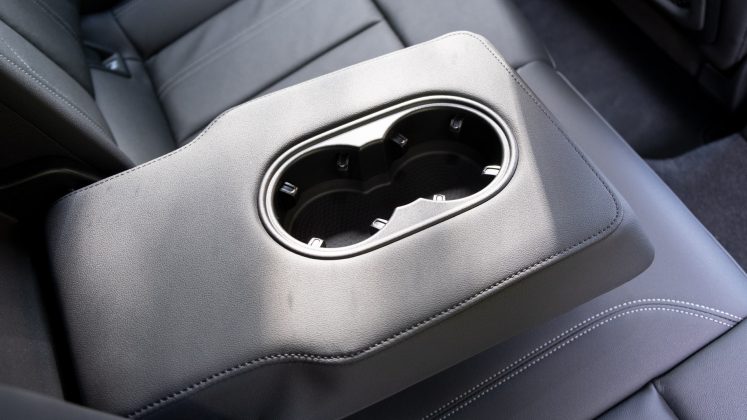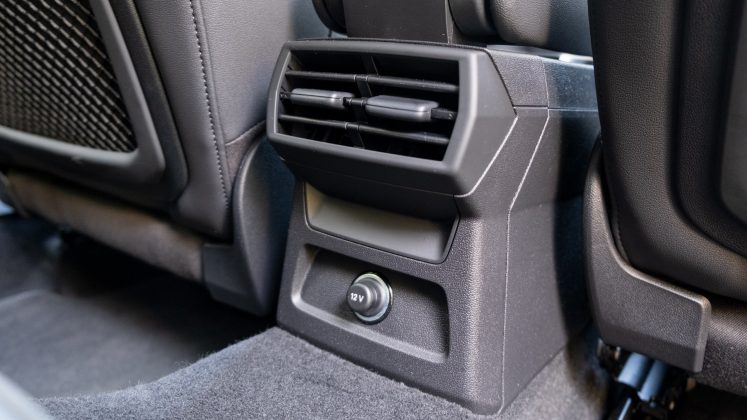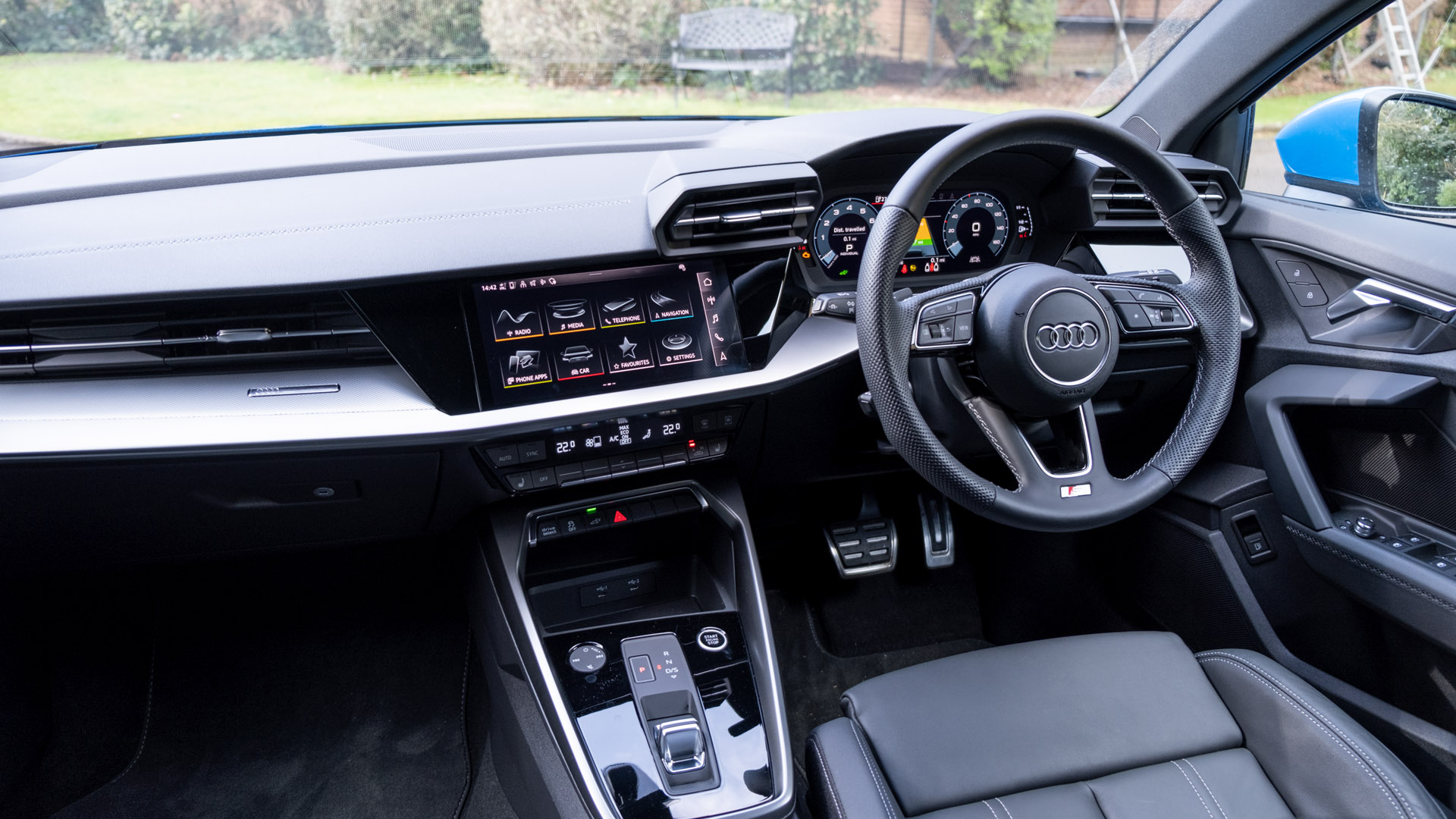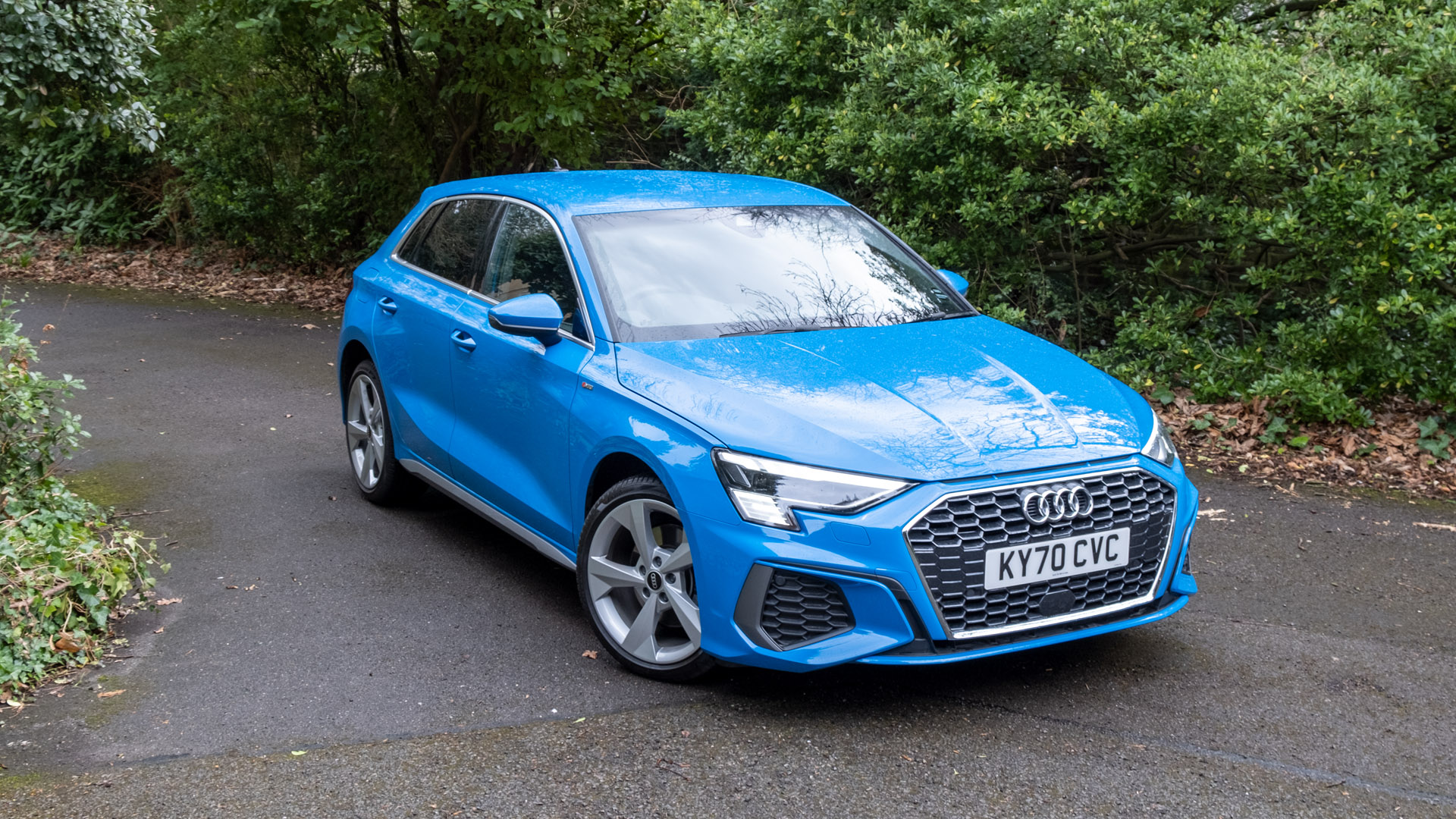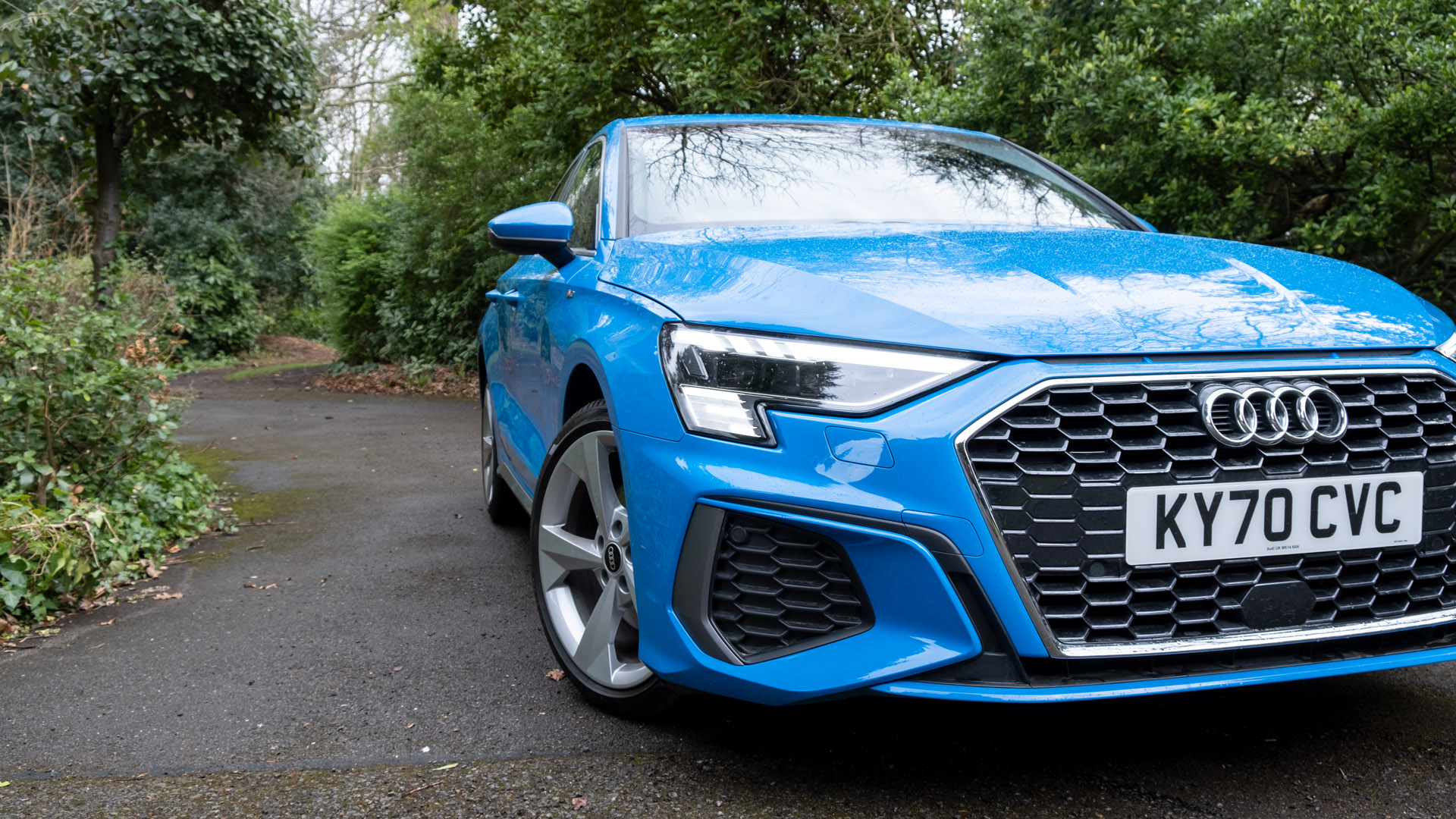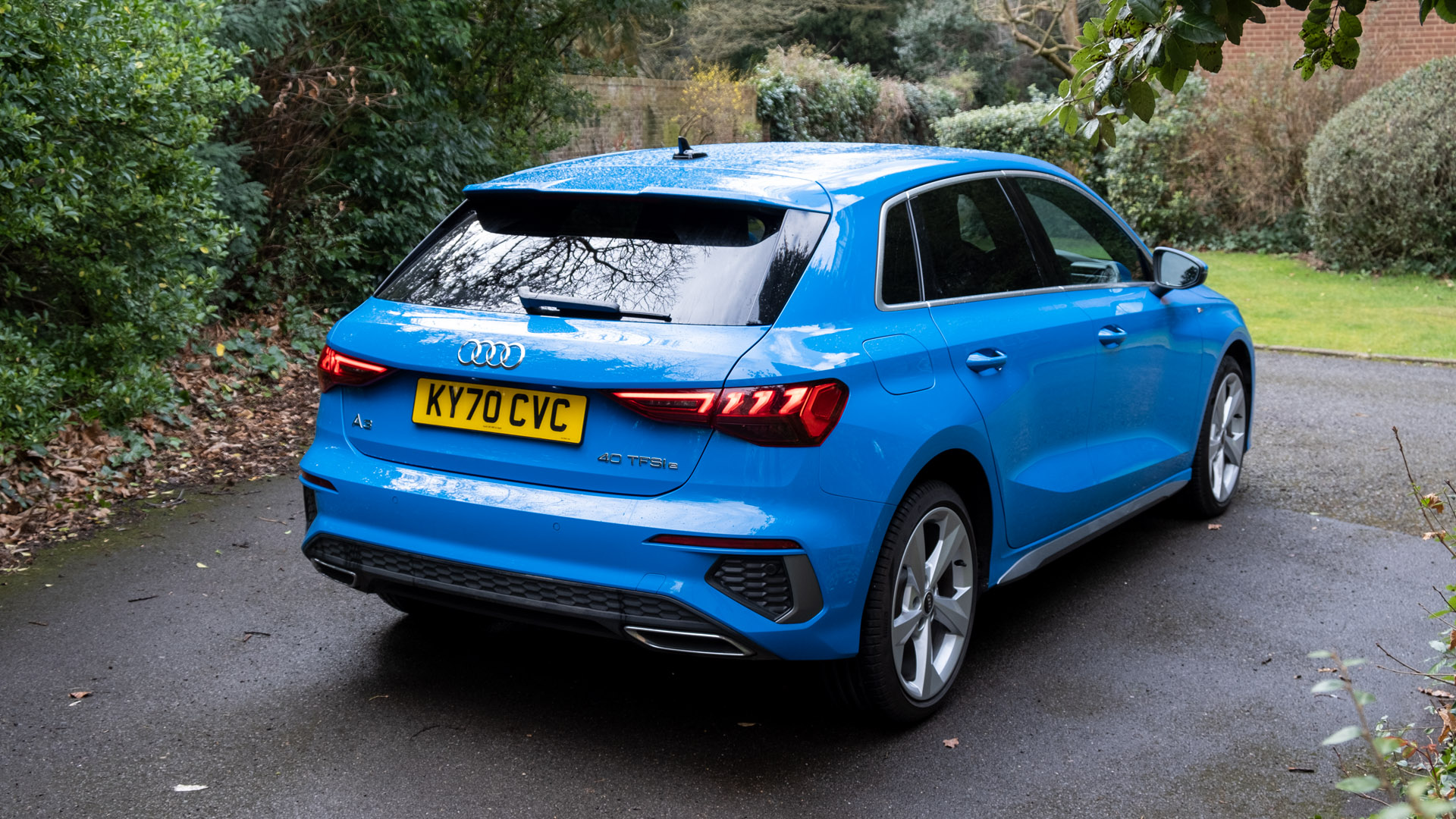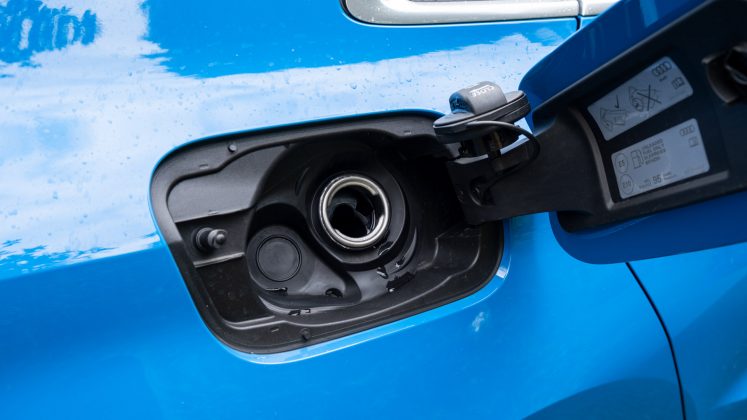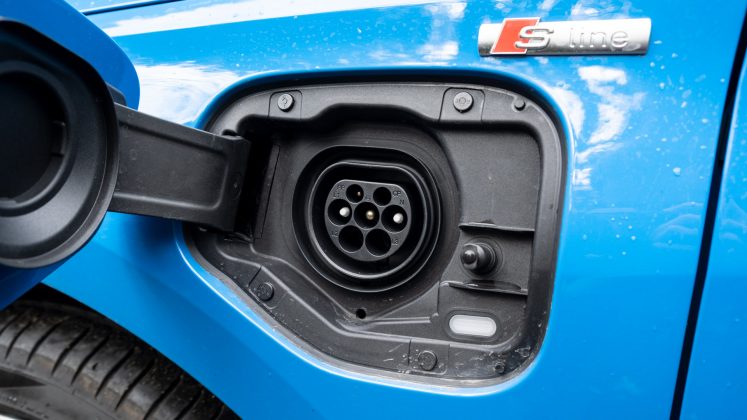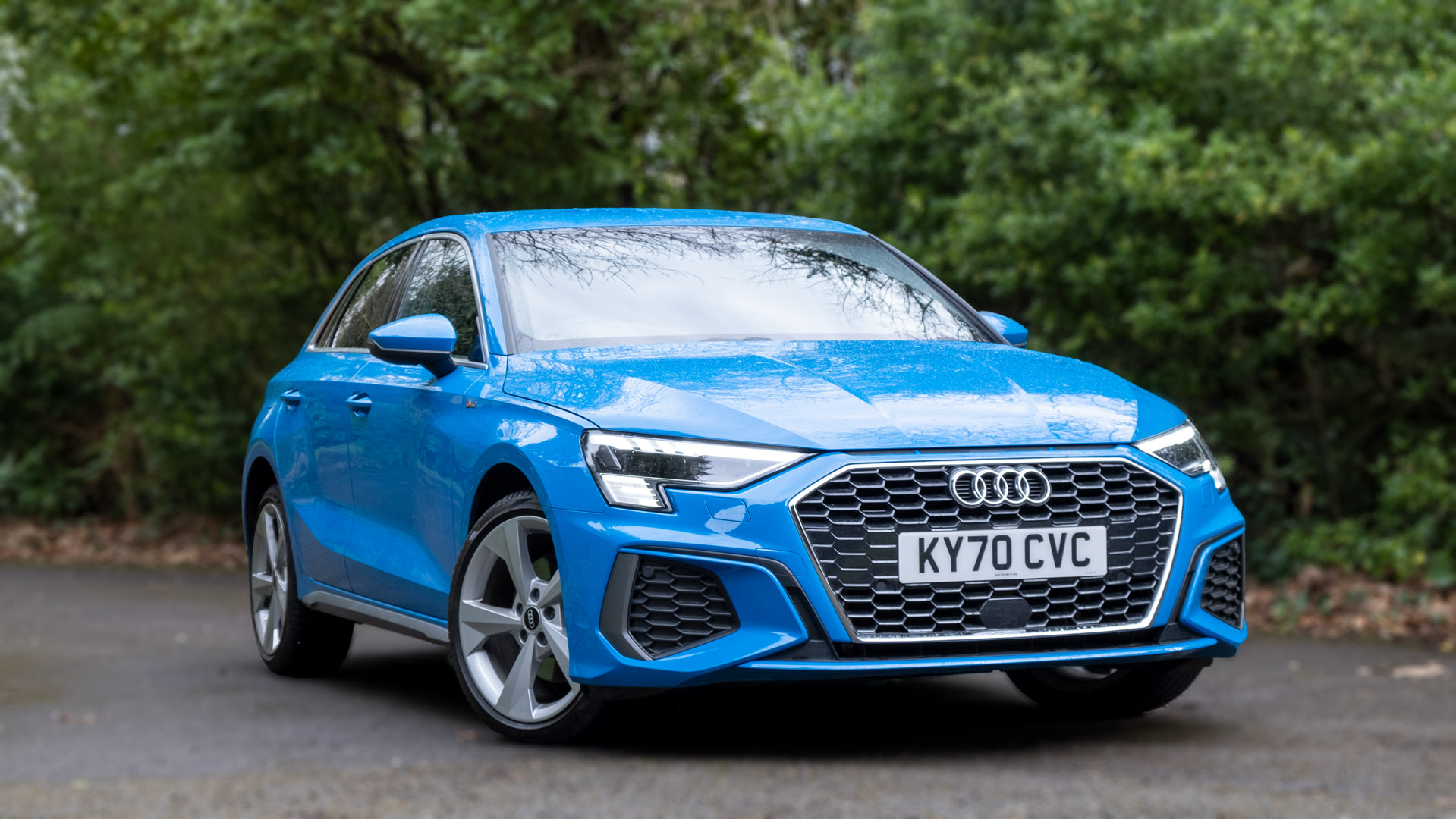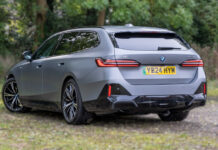Introduced in 1996, the Audi A3 has progressively grown in popularity, whereby it’s effectively a more luxurious proposition over Volkswagen’s other vehicles that share the same MQB Evo platform: the VW Golf, Seat Leon and Skoda Octavia.
Now in its fourth generation, the A3 is offered in a few model configurations: A3 Sportback, A3 Saloon, A3 Sportback TFSI e, S3 Sportback and S3 Saloon. The one we’ll be concentrating on is the plug-in hybrid, the A3 Sportback 40 TFSI e.
If you’d prefer to watch a review of the Audi A3 TFSI e, head on over to our YouTube channel.
Audi A3 TFSI e price & competition
The price of the hybrid model starts from £33,060 with the ‘Sport’ trim that comes as standard with the following options:
- 1.4-litre four-cylinder engine and 80 kW motor, which combined output 150 kW (201 hp), 350 Nm of torque and get to 62mph in a claimed 7.6 seconds
- Front-wheel-drive system with 6-speed S tronic dual-clutch transmission
- 13 kWh battery nets 37 to 40 miles of driving range (WLTP test cycle)
- LED headlights with LED daytime running lights
- 17″ x 8.0J ‘5parallel-spoke’ alloy wheels
- Electrically adjustable, heated and folding side mirrors
- Front 12V socket and two USB Type-C ports
- 10.1″ infotainment system with MMI Navigation Plus, Android Auto and Apple CarPlay
- 10.25″ instrument cluster using Audi’s Virtual Cockpit
- 6-speaker audio system
- Manually adjustable front seats
- 3-spoke leather steering wheel with gearshift paddles
- Safety system include: Audi pre sense (front), rear parking sensors, hill-hold assist, lane departure warning, cruise control and collision avoidance assistant
Move up to the S line at £34,960 and you get the following added on top:
- 18″ x 8.0J ‘5-arm dynamic’ alloy wheels
- LED headlights with LED rear lights and dynamic rear indicators
- S line styling, including spoiler and bumpers
- Privacy glass: dark-tinted rear window, rear door and side windows
- Front sport seats
- Dark spectrum aluminium inserts on the dashboard
- LED interior Lighting Pack
- Front and rear centre armrest in leather
- Stainless steel pedals and front footrest
Transition to the top-spec S line competition, and it’ll set you back £36,710; this nets you:
- 1.4-litre four-cylinder engine and 80 kW motor, which combined output 180 kW (242 hp), 400 Nm of torque and get to 62mph in a claimed 6.8 seconds – extra power is achieved due to ECU tweaks
- 18″ x 8.0J ‘5-Y-spoke style’ diamond-cut alloy wheels
- Black styling across the exterior design
- Red brake calipers
As for colour options, it’s available in ‘Ibis White’ at no extra cost. The pictured ‘Turbo Blue’ is a £575 option, and so are the metallic finishes: Navarra blue, Python yellow, Glacier white, Mythos black, and Tango red. The ‘Daytona grey’ pearl option will also set you back the same amount.
When it comes to its rivals, there are a handful of plug-in hybrid alternatives to consider: the VW Golf MK8 GTE at £35,960, the Mercedes A 250 e at £32,980, the Seat Leon e-Hybrid at £32,835 and the saloon-sized Skoda Octavia iV at £33,150.
Aside from PHEVs there are a plethora of all-electric hatchbacks and saloons to choose from: the rapid Tesla Model 3 costs £43,490; the sporty BMW i3 from £36,575; the Hyundai Ioniq Electric starts from £31,450; the spacious Renault Zoe starts from £27,495; the comfy Nissan Leaf at £27,345; the tech-focused Honda e at £27,660; the familiar-looking Vauxhall Corsa-e at £27,140; the stylish Mini Electric at £25,500; the bite-sized Volkswagen e-up! starts from £23,055 with its near-identical sibling, the Seat Mii Electric, coming in at £20,300.
Read next: A list of our favourite phone holders
While we won’t ever recommend a non-electrified vehicle, we do have to acknowledge the price difference between the regular A3 and the hybrid model. Here, the A3 Sportback starts from £23,300 for the Technik and goes up to £42,675 for the Vorsprung trim. The PHEV’s closest sibling, at least in terms of styling and a like-for-like engine (minus the electric motor, of course) would be the Sport 35 TFSI S tronic, which costs £27,815. Should you go for an equally-powerful (~201hp) A3, the Sport 40 TDI quattro S tronic that has a 2-litre diesel engine and costs £32,700 would be your cheapest option.
Don’t forget, however, if you’re buying the Audi A3 as a company car, your benefit-in-kind tax is significantly reduced if you opt for the hybrid model. It’s effectively eliminated if you go for a pure electric vehicle, instead. Logically, the greener you go, the less tax you have to pay.
Read next: Government car grant for electric cars: A complete guide on the PICG
Audi A3 TFSI e exterior review
Despite its comparatively high asking price, the Audi A3 TFSI e looks the part. It’s arguably one of the best looking cars in its class. At the front, there is an oversized grille, but it blends well with the rest of the vehicle’s design. Chrome accents and subtle black styling around the front bumper also bolster the vehicle’s design. The A3’s headlights are aggressively styled, with the car’s bonnet receiving a similar sporty treatment.
Over the years, it would seem Audi has slowly transformed the A3 from a bubble-shaped car with a somewhat uninspiring design, to one that has a low-profile, sporty look – and we’re all for it. The same design philosophy extends to the side of the vehicle, where body-coloured mirrors, sideskirts and wheel arches add to a cohesive look. 17″ alloys come as standard, but should you wish to up the ante with 18″ alloys – such as the one pictured on the Sport line – these can be added on, too.
Around the back, stylish tail lights take centre stage with their unique look. A slim spoiler also adds that sporty edge. Purists will be disappointed to find fake exhaust outlets around the back, though, most won’t mind Audi’s use of concealed downward-facing tailpipes.
Read next: Citroen e-C4 first drive: A comfortable all-electric SUV
Audi A3 TFSI e interior review
Inside, the A3 TFSI e is exquisite. The overall look seems to have been inspired by the automaker’s more premium models, such as the A7 or A8. It just oozes quality and feels premium, too.
It’s not just the looks that count, however, as the German automaker has also spent time on optimising practicality. Take the climate controls, they’re easy to press, where physical buttons and levers are found under the vehicle’s infotainment display. Just above them sits a monochrome LCD display that shows the fan speed, climate controls and AC mode.
Toward the centre console, there’s an intuitive volume wheel that responds to touch input. Stroke it anti-clockwise and it’ll reduce the system’s volume, and move clockwise to do the opposite. The wheel also serves to control media, where it has integrated buttons to go back or skip a track, and another to mute the system.
Likewise, the electronic gear selector is each to operate: the ‘P’ button initiates Park, while the sleek lever found beside it allows you to pop the car in Reverse, Neutral, and switch between Drive and Sport mode.
Read next: The best dash cams to mount inside your vehicle
Should you prefer to alter the gears manually, flappy paddles behind the steering wheel provide for an intuitive experience. Speaking of which, a flurry of physical buttons on the wheel itself allows for better interaction with media, and further helps with customising what’s displayed on the 10.25″ instrument cluster.
The fully digital display integrates Audi’s Virtual Cockpit, which can be customised to a certain degree. We particularly like the integration of the Navigation Plus system that can, if desired, be stretched the length of the display.
Unfortunately, the instrument cluster doesn’t integrate with Android Auto or Apple CarPlay, such as the one found on the Polestar 2 that fully integrates Google Maps. As such, you’ll need to resort to the 10.1″ infotainment system for your navigation data. Still, the main MMI interface supports both Android Auto and Apple CarPlay, and makes it easy to navigate through the menu system.
To wirelessly connect up to the infotainment system, one has to use Bluetooth, where both the AAC and SBC codecs are supported. On the subject of audio, the A3 TFSI e has an impressive six-speaker configuration that comes as standard – if you’d like to know how it sounds, head on over to our YouTube channel.
Read next: MG ZS EV review: An affordable all-electric SUV
Audi A3 TFSI e storage review
Should you opt for a wired connection instead, the car has two USB Type-C ports found by the centre console. There’s a non-slip compartment to place a smartphone, however, should you use a wired connection with a larger-sized device – such as the pictured Samsung Galaxy S10+ – you’ll find it doesn’t fit properly.
If you don’t mind trailing a cable toward the armrest, one can place a smartphone conveniently within the larger storage compartment, here you’ll be able to store a few larger-sized valuables such as a waller or purse. Elsewhere, the glove compartment allows you to store larger valuables, and the small bay found by the steering wheel caters for loose change.
The front doors themselves can squeeze a 500ml bottle and a few possessions, while the rear two are a little more limited. You can also place two coffee cups by the centre console, and should you want more space, the two plastic cup holders can be retracted to reveal a medium-sized storage compartment.
Read next: The best dash cams to mount inside your vehicle
Onto the boot, there’s 280 litres of space and 1,110 litres with the seats folded flat; a figure that is 100 litres off its ICE counterpart, as the underfloor compartment houses the vehicle’s 13 kWh battery pack.
Here’s how its boot capacity stacks up to a few of its all-electric rivals: Nissan Leaf (435/1,161 litres); Hyundai Ioniq Electric (357 /1,417 litres); VW ID.3 (385/1,267 litres); Renault Zoe (338/1,225 litres); Corsa-e (267/1,076 litres); VW e-up! (251/951 litres); Seat Mii Electric (251/923 litres); Mini Electric (211/731); Honda e (171/571 litres).
While its storage capacity isn’t vast, we do like that Audi has integrated a 40:20:40 split, which allows for you to prop down the middle seat to transport elongated goods while still having two occupants at the rear of the vehicle. Better still, the boot floor is flat with only a slight lip, which makes loading and unloading good from the A3 a breeze.
Read next: Renault Zoe review: Best electric family car?
Audi A3 TFSI e comfort review
Moving onto comfort, Audi uses front sport seats in the ‘Sport’ variant, which we have on review. They are a little on the firm side, but don’t cause any discomfort when driving on the motorway. Likewise, they’ll keep you strapped in should you throw the car around on country roads.
It’s a shame not to see electronically adjustable front seats, although, 4-way lumbar support can be purchased as a £260 option. Furthermore, the 12V outlet that is preset at the rear of our A3’s cabin is also disappointedly part of a ‘Storage Pack’. This is part of a £185 pack that adds rear cupholders found within the middle seat, and storage nets behind the front two seats. We’d have liked these features to be included as standard.
As for headroom and legroom, it’s excellent both at the front and rear of the cabin; while the A3 won’t offer as much space as an SUV or estate, for its segment, it’s class-leading. Here, 6-foot 4-inches (193cm) individuals can be seated without feeling henned in. Similarly, visibility for the driver is flawless, with large windows both at the front and the back, making for easier parking.
Yet again, it is disappointing not to see front parking sensors and a rearview camera fitted as standard. Instead, you’ll have to opt for the £1,195 ‘Comfort and Sound’ pack to get access to these features alongside heated front seats and a 15-speaker Bang & Olufsen sound system.
Indeed, you might need to turn up the audio system to block out exterior noise, as the A3 TFSI e, similar to the Mercedes A-Class, suffers from cabin noise. It’s not a massive problem when pottering around inner-city routes, but can be distracting when driving at speed on the motorway; tyre noise is an inherent problem on these vehicles.
Read next: Hyundai Kona Electric review: Kia e-Niro alternative?
Audi A3 TFSI e performance review
On the subject of tyres, the A3 TFSI e relies on a front-wheel-drive (FWD) system, which struggles for grip when you put your foot down to the metal. Here, stability is an issue when you’re launching the car from a standstill or if you want to have full confidence when driving at speed on wet roads. Audi’s Quattro four-wheel-drive system would have been a great addition to the car – it’s available in the non-hybrid models such as the Sport 40 TDI quattro S tronic.
Despite it running on an FWD system only, the A3 is stable around windy country roads. The car stays well-planted and doesn’t lose its shape. Body roll is minimal too, where the suspension setup has been tweaked to make the car feel more responsive. It’s certainly one that instils a driver’s feel and is exactly what you’d want from a sport compact.
Unsurprisingly, it’s not as soft as the VW Golf or Octavia when driving over potholes and speed bumps. We’d also say the Mercedes A-Class has a slightly more cushiony experience but isn’t far off the A3’s suspension.
As for performance, the A3 TFSI e has a 1.4-litre four-cylinder engine and 80 kW motor, which combined output 150 kW (201 hp), 350 Nm of torque and will take you from a standstill to 60mph in 7.03 seconds – tested using Racelogic’s Vbox Sport. It’ll also attain a top speed of 141.1mph in hybrid mode, and 140mph in pure EV mode.
Speaking of which, the transition between the two powertrains is seamless. You will, of course, know when the engine has kicked into life, as you’ll hear it trickling away. We should also state that if you were to initiate a kick-down, the engine does rev to around 5,000-6,000 RPM, making for a bit of a racket.
Thankfully, that only occurs when you’re desperately trying to extract power from its four-cylinder engine. Should you naturally progress through the six-speed gearbox, you’ll find the car doesn’t exhibit too much engine noise. Here, the dual-clutch S tronic system is buttery smooth – one can flick through the six gears immediately through the flappy paddles; there’s no lag between each shift. Should you prefer the car to determine which gear to be in, both Drive and Sport mode allow for a less hands-on experience – the latter mode will shift gears a little later, keeping the revs a bit higher for that sporty feel.
As for the electric portion, the A3 TFSI e houses a small 13 kWh battery pack, which claims to run for 37 miles using the 17″ alloys or 40 miles on the 18″ wheels. However, in our mixed driving tests, we found this figure sat closer to the 30-mile mark, with it dropping down to 25 miles on the motorway. It’s not great, but neither are most plug-in hybrids in its class range – you’ll be hard-pressed to squeeze 35 miles from any small-sized PHEV.
On the plus side, this should suffice for most consumers to drive in pure EV mode on their daily commutes. Those who have the ability to recharge at work or at home will want to lower fuel costs and further maximise efficiency. In this respect, the car’s 40-litre petrol tank offers up to 340 miles of range, and combined with its EV competencies achieve a staggering 58.2 MPG. Given the car’s size, this is incredible and is a testament to the car’s overall fuel efficiency.
Read next: MG5 EV review: The affordable fully electric estate
Given this is a plug-in hybrid, there is a charging flap found by the passenger’s side A-pillar. The Type 2 port is limited to 2.9 kW, which means a full charge from empty will take a whopping four hours. One could have hoped for an increased charge rate, which would have encouraged more drivers to use EV mode, especially if one doesn’t have easy access to a wallbox charger.
There’s also a slight degree of regenerative braking, which comes into effect when you apply pressure on the brake pedal. The amount it recoups is pretty impressive.
As for safety systems, this PHEV lacks the plethora of systems found as standard on Audi’s more expensive vehicles. Here, the A3 has lane departure warning and basic cruise control settings, only. Should you want parking assistance, traffic sign recognition, and adaptive cruise control, you’ll need to opt for the £1,750 ‘Driver Assistance’ pack. There’s no option to add a head-up display, either – a feature we’d like to see come as standard in more vehicles.
Read next: Kia e-Niro review: The best all-electric SUV?
TotallyEV’s verdict on the Audi A3 TFSI e
On the whole, the Audi A3 TFSI e is a good small-sized car that has a luxurious design both in and out of the cabin. It’s plenty of fun to drive and is surprisingly fuel-efficient, too. One should consider, however, its purpose in the market.
Should you look past its classy design, you’ll find the more practical and cheaper VW Golf GTE, the Seat Leon e-Hybrid and at a stretch, the Skoda Octavia iV. Should you wish to lower your BIK rate even further, and still want to travel over 200 miles on a single charge, you should consider the all-electric VW ID.3, Renault Zoe and the Nissan Leaf. The former from the Volkswagen Group is arguably the better drive, where its RWD system will leave you with a smile on your face.
Effectively, the reason you’d get the A3 TFSI e over any of the aforementioned vehicles is if you want a sporty look and want the ability to refuel within minutes at a petrol station. If you don’t fall within this category, we’d urge you to look at its alternatives.
What do you make of the compact PHEV? Let us know in the comments below or via social media; we’re on: YouTube, Instagram, Facebook, Twitter and LinkedIn.

